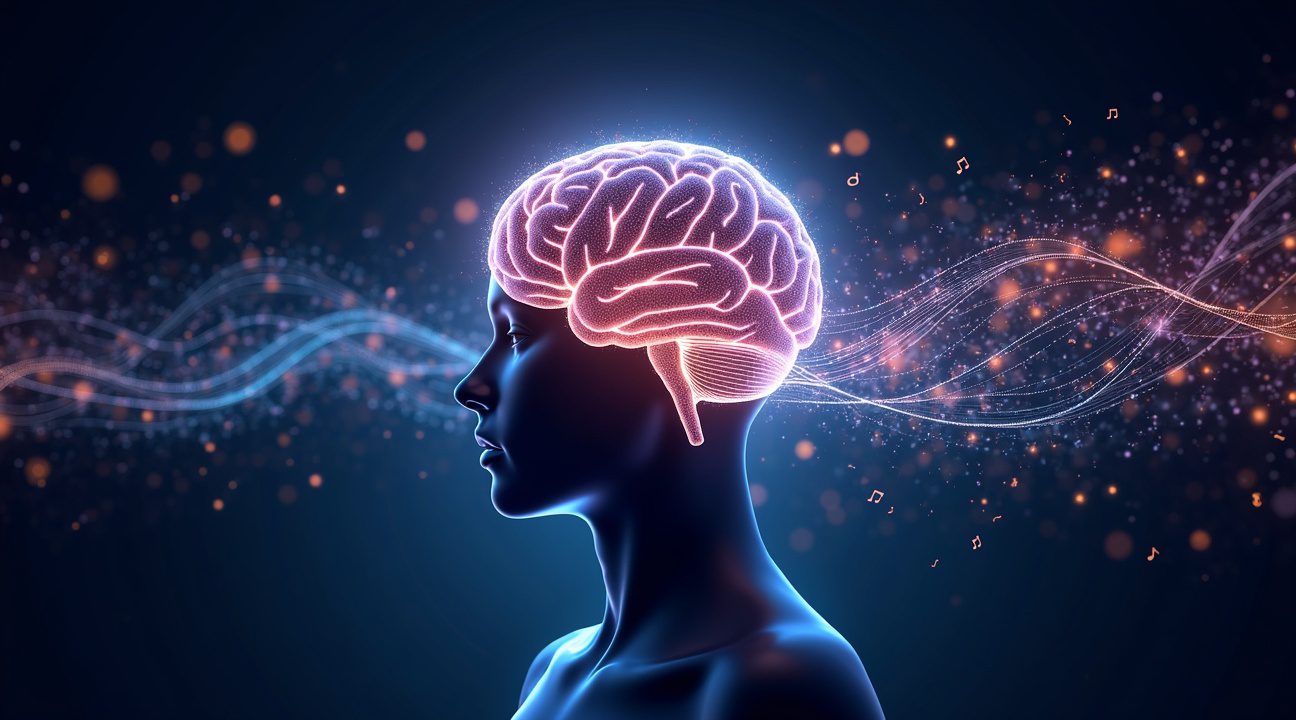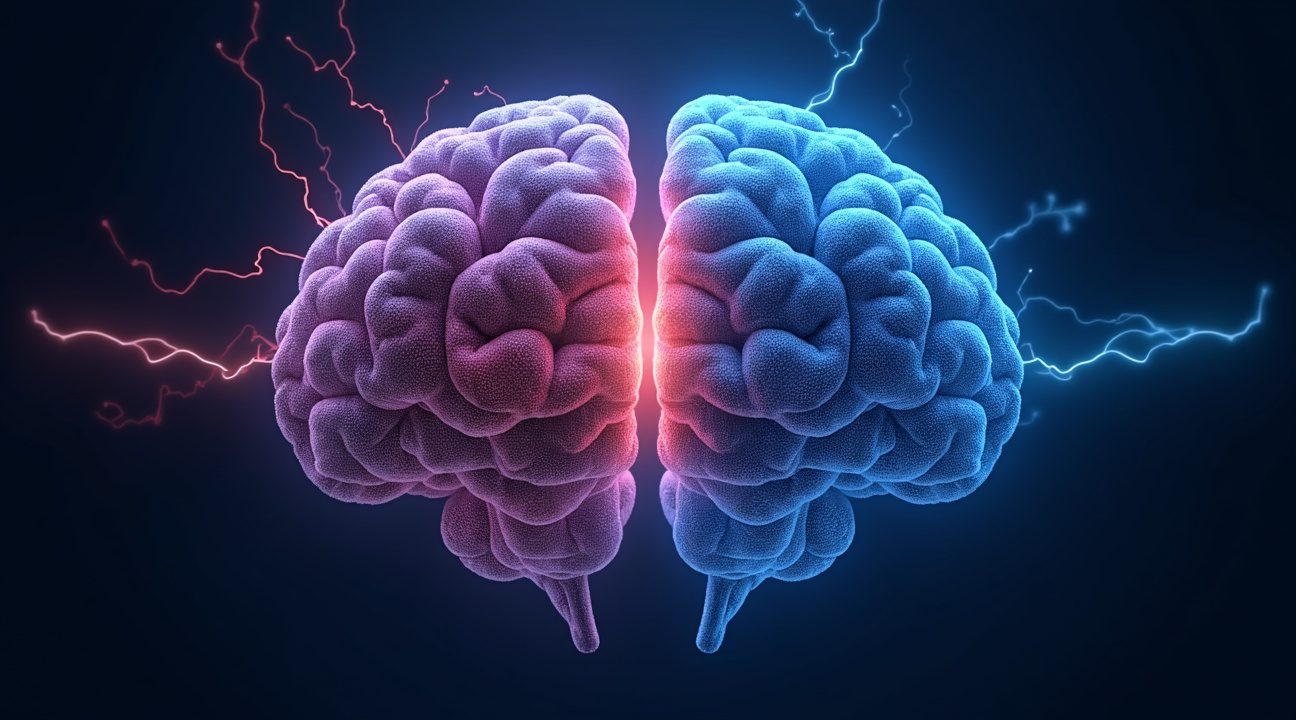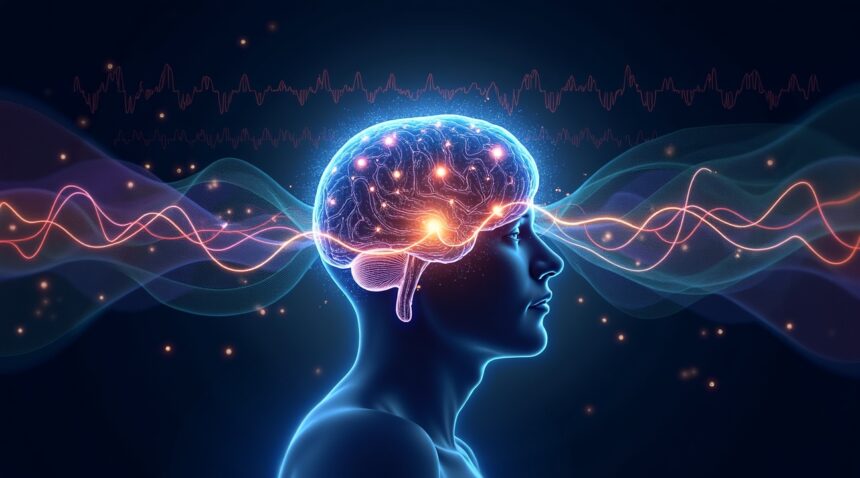Recent research demonstrates that music creates direct synchronization between external rhythms and the brain’s natural electrical oscillations, fundamentally altering how scientists understand musical experiences at a neurological level.
This groundbreaking discovery reveals that brains don’t simply process music passively but physically align with musical elements through measurable changes in neural activity, brain chemistry, and cardiovascular function.
Key Takeaways
- Neural Resonance Theory shows that brains physically synchronize with music through electrical oscillations that match rhythm, melody, and harmony regardless of cultural background or musical training.
- Fast-tempo music enhances cognitive networks and connectivity between frontal, temporal, and occipital brain regions, while slow-tempo music activates relaxation circuits and increases default mode network activity.
- Music triggers measurable chemical changes including 9–21% increases in dopamine levels and creates cardiovascular effects like reduced heart rate and blood pressure that can induce meditative brain states.
- Medical applications now use targeted musical interventions to treat stroke recovery, Parkinson’s disease, and depression by leveraging the brain’s natural tendency to synchronize with external rhythms.
- Revolutionary technologies incorporate music-based approaches in AI systems that respond to physiological states, educational tools that align with brain development patterns, and therapeutic platforms that adapt to individual neural responses.
To explore this topic further, you can visit an article on Scientific American’s coverage of brain-music synchronization.
Neural Resonance Theory (NRT)
Neural Resonance Theory represents a groundbreaking shift in understanding how music affects the human brain. I’ve observed through research that this theory fundamentally reframes our comprehension of musical experiences by demonstrating that our brains don’t simply process music—they physically synchronize with it through natural electrical oscillations.
The core principle of NRT reveals that musical experiences emerge when our brain’s inherent electrical patterns align, or ‘resonate,’ with external musical elements including rhythm, melody, and harmony. This synchronization process operates at a biological level, creating a direct connection between musical stimuli and neural activity that goes far beyond simple auditory processing.
What makes this theory particularly fascinating is how it explains the automatic physical responses I notice people have to music. When someone starts tapping their foot to a beat or feels compelled to dance, their brain’s electrical oscillations are literally matching the musical rhythm. This resonance doesn’t just affect timing—it influences musical pleasure and generates the irresistible urge for movement that accompanies engaging musical experiences.
NRT challenges conventional wisdom about music’s psychological impact. Traditional theories suggested that music’s power stemmed primarily from learned associations, cultural conditioning, or cognitive expectations built through repeated exposure. However, Neural Resonance Theory demonstrates that music’s influence is fundamentally embodied in the brain’s natural capacity to coordinate with musical patterns, regardless of prior learning or cultural background.
Cross-Cultural and Neurological Evidence
Research supporting NRT shows remarkable consistency across diverse populations and musical traditions. The brain’s resonance patterns for fundamental musical structures like pulse and harmony remain stable whether someone grows up listening to Western classical music, African drumming, or Asian pentatonic scales. This suggests that musical resonance operates at a deeper neurological level than cultural programming.
The theory extends beyond the auditory cortex to encompass multiple brain regions. When musical resonance occurs, I can see how it activates networks responsible for:
- Motor control and coordination, explaining spontaneous rhythmic movement
- Emotional processing centers, creating the feelings of pleasure or excitement music generates
- Memory formation areas, enhancing how musical experiences become embedded in long-term recall
- Social bonding regions, facilitating the shared experiences that make group musical activities so powerful
The integration of hearing with physical sensation represents one of NRT’s most significant insights. Rather than treating auditory processing as separate from motor function, this theory demonstrates how musical resonance creates unified experiences that engage both sensory perception and physical response simultaneously.
This understanding has practical implications for various applications. Music therapists can leverage Neural Resonance Theory to develop more effective treatments for neurological conditions by targeting specific oscillation patterns. Similarly, sleep research has begun exploring how musical resonance might influence brain rhythms during rest and recovery.
The theory also explains why certain musical elements feel universally compelling. Rhythmic patterns that match natural brain oscillations—typically falling within specific frequency ranges—create stronger resonance effects. This is why certain tempos feel naturally energizing while others promote relaxation, regardless of an individual’s musical training or preferences.
Understanding Neural Resonance Theory opens new possibilities for enhancing cognitive performance, emotional regulation, and physical coordination through targeted musical interventions. The brain’s capacity to synchronize with external rhythms represents a fundamental aspect of human neurology that extends far beyond entertainment, touching on essential mechanisms of perception, movement, and social connection.

Fast Versus Slow Tempos Create Opposite Effects in Brain Networks
EEG studies have revolutionized our understanding of how music tempo directly influences brain activity patterns. I’ve observed through recent research that fast and slow musical tempos create dramatically different neural responses, essentially rewiring our brain networks in real-time.
Fast Tempos Supercharge Cognitive Networks
Fast-tempo music acts like a neural accelerator, increasing connectivity strength across multiple brain regions simultaneously. The frontal, temporal, and occipital areas show heightened activity levels, reflecting the brain’s response to increased cognitive and emotional demands. This enhanced connectivity pattern demonstrates how upbeat music literally synchronizes our neural networks.
The synchronization between frontal and parietal areas becomes particularly pronounced during fast-tempo exposure. This connection directly links musical tempo to increased arousal and cognitive processing capabilities. Think of it as your brain shifting into high gear – neurons fire more rapidly, communication between regions intensifies, and overall neural efficiency improves. Brain potential reaches new heights as these networks coordinate their activity.
Slow Tempos Activate Relaxation Circuits
Slow-tempo music triggers an entirely different neural response pattern. Rather than ramping up activity, it reduces synchronization in frontal and temporal regions while enhancing low-frequency activity between occipital and parietal areas. This shift promotes relaxation and emotional stability through a completely different mechanism than fast music.
The most fascinating aspect involves how slow music enhances functional connectivity in two specific networks:
- The default mode network (DMN) becomes more active, which researchers associate with introspective thinking and emotional processing.
- The sensorimotor network (SMN) shows increased connectivity, contributing to the calming physical sensations people experience during slow music listening.
These networks work together to create what I call the “relaxation response.” Low-frequency brain waves increase, stress hormones decrease, and the nervous system shifts from sympathetic to parasympathetic dominance. The power of music becomes evident as these physiological changes occur within minutes of exposure.
The implications extend beyond simple relaxation. Enhanced DMN connectivity during slow music exposure suggests improved emotional regulation capabilities. People often report better mood stability and reduced anxiety after listening to slower musical pieces, and now we understand the neural mechanisms behind these effects.
Fast tempo exposure creates the opposite pattern – reduced DMN activity but increased executive network engagement. This explains why energetic music helps with focus-demanding tasks but may interfere with relaxation or emotional processing. The brain essentially chooses between different operational modes based on musical input.
Modern neuroscience reveals that these tempo-induced changes happen remarkably quickly. EEG measurements show altered brainwave patterns within 30 seconds of musical exposure. The speed of these changes suggests that our brains evolved to use auditory rhythms as environmental cues for appropriate neural states.
Practical Applications of Tempo in Daily Life
Understanding these mechanisms has practical applications for daily life:
- Fast-tempo music becomes a tool for enhancing cognitive performance during work or exercise.
- Slow-tempo pieces serve as natural relaxation aids and emotional stabilizers.
The key lies in matching musical tempo to desired brain states rather than random selection.
The research also connects to broader patterns in music production, where artists intuitively understand these effects even without knowing the underlying neuroscience. Producers often manipulate tempo to create specific emotional responses, validating what scientists now measure directly in brain activity patterns.
These findings demonstrate that music tempo functions as a non-invasive method for modulating brain network activity. Unlike pharmaceutical interventions, musical tempo changes create immediate, reversible effects on neural connectivity patterns without side effects or long-term dependencies.
https://www.youtube.com/watch?v=4N3N1MlvVc4

Music Triggers Measurable Chemical and Physical Changes in Your Body
Music doesn’t just entertain your ears—it fundamentally alters your brain’s chemistry and your body’s physical responses. When you listen to songs that resonate with you, your brain releases dopamine at levels that spike between 9% and 21%, creating the same reward pathways associated with food, exercise, and other pleasurable activities. This neurochemical reaction explains why certain melodies can instantly lift your mood or transport you back to vivid memories.
The synchronization between musical rhythm and your brain’s natural oscillations creates a direct pathway for emotional and memory formation. Your brain actively matches the tempo and patterns it hears, which triggers distinct emotional responses ranging from calm tranquility to energetic excitement or deep nostalgia. This synchronization process influences how you process and store memories, making music a powerful tool for both learning and emotional regulation.
Physical Impact Beyond the Brain
Music’s effects extend far beyond mental responses, creating measurable changes throughout your cardiovascular system. Studies show that listening to preferred music can slow your heart rate and reduce blood pressure, effectively shifting your body into a more relaxed state. These changes can be so pronounced that your brain enters what researchers identify as a meditative state, similar to what occurs during mindfulness practices or deep sleep cycles.
Healthcare professionals have recognized these physiological benefits and increasingly incorporate music into clinical settings. Hospitals now regularly use carefully curated playlists in recovery rooms to help patients maintain calm states before and after surgical procedures. This application of music therapy demonstrates how sound can serve as a non-pharmaceutical intervention for managing stress and promoting healing.
The clinical benefits extend to stimulating your brain’s default mode network, which becomes active during rest and introspection. When music activates this network, it creates bridges between your brain’s logical processing centers and emotional regions, effectively unlocking creative potential. This connection explains why many people experience their best ideas while listening to music or why certain songs can inspire artistic breakthroughs.
Your body’s response to music operates on multiple levels simultaneously. While dopamine floods your reward pathways, your nervous system adjusts heart rate and blood pressure, and your brain networks reorganize to facilitate both emotional processing and creative thinking. These changes occur whether you’re actively listening or have music playing in the background, though the intensity varies based on your personal connection to the specific sounds you’re hearing.
Modern technology advances allow researchers to measure these responses in real-time, confirming what musicians and listeners have long suspected—music creates profound, measurable changes in human physiology. The combination of chemical releases, cardiovascular adjustments, and neural network activation makes music one of the most comprehensive non-invasive therapies available for both physical and mental wellness.
This understanding has practical applications beyond healthcare settings. Workplace environments, educational institutions, and fitness facilities increasingly use strategic music selection to influence productivity, learning outcomes, and performance levels. The science confirms that music isn’t just entertainment—it’s a powerful tool for optimizing human function and well-being through direct biological mechanisms.
Revolutionary Applications in Medicine, AI, and Education
The groundbreaking discoveries about music’s influence on neural rhythmic timing (NRT) have opened doors to transformative applications across multiple fields. I see these findings reshaping how we approach healing, technology, and learning in ways that were previously unimaginable.
Medical Breakthroughs Through Music-Based Therapy
Music therapy has evolved from complementary treatment to evidence-based medicine for serious neurological conditions. Patients recovering from stroke now benefit from rhythm-based interventions that help rebuild neural pathways, while individuals with Parkinson’s disease use musical cues to improve motor function and gait stability. Depression treatment has also been enhanced through targeted musical interventions that regulate emotional processing centers in the brain.
These therapeutic approaches work by leveraging the brain’s natural tendency to synchronize with external rhythms. Healthcare providers can now prescribe specific musical patterns to stimulate healing responses, making treatment more engaging and effective than traditional methods alone. The precision of these interventions continues to improve as researchers identify which musical elements produce the strongest therapeutic outcomes.
Emotionally Intelligent AI and Creative Technology
Artificial intelligence systems equipped with understanding of NRT can now generate and respond to music in real-time, creating unprecedented opportunities for healing and communication. These emotionally intelligent platforms analyze a person’s physiological state and generate musical responses designed to promote specific emotional or cognitive outcomes.
Creative technology companies are developing interfaces that use music as a bridge between human emotion and digital interaction. Gaming environments incorporate adaptive soundscapes that respond to player stress levels, while therapeutic apps adjust their musical output based on biometric feedback. Entertainment platforms can now create personalized musical experiences that adapt to individual neural patterns, enhancing both engagement and emotional well-being.
Transforming Education Through Music
Music-based learning technologies represent another frontier where NRT research proves invaluable. Educational tools now incorporate rhythm and pitch training that aligns with natural brain development patterns, helping both children and adults acquire musical skills more efficiently. These systems can identify optimal learning windows and adjust their teaching methods accordingly, making musical education more accessible and effective.
Schools implementing these technologies report improved cognitive performance beyond musical ability. Students show enhanced pattern recognition, mathematical reasoning, and language development when musical training aligns with their brain’s natural rhythmic preferences. The technology adapts to individual learning styles, ensuring that each student receives instruction at their optimal pace and complexity level.
Cross-Cultural Communication and Music’s Universal Language
Cross-cultural research reveals why music serves as a universal human connector despite surface-level differences in musical preferences. While different societies may favor unique rhythmic ratios and melodic structures, the underlying brain mechanisms that respond to musical input remain consistent across cultures. This discovery explains why people from vastly different backgrounds can still find common ground through musical expression.
The universal nature of these neural responses has significant implications for global communication and cultural exchange. Pop culture increasingly leverages these shared neural pathways to create content that resonates across cultural boundaries. International collaboration in music production and therapeutic applications becomes more effective when practitioners understand these fundamental brain patterns.
Research institutions worldwide are now sharing data about cultural musical preferences while recognizing the underlying biological constants. This collaboration accelerates the development of both therapeutic interventions and creative technologies that can be adapted for different populations while maintaining their effectiveness.
The Future of NRT Applications
The implications of NRT research extend far beyond current applications. As our understanding deepens, we’ll likely see integration of musical therapy with other treatments, more sophisticated AI systems that can truly understand human emotional states, and educational technologies that revolutionize how we learn and develop cognitive skills. These advances promise to make music an even more powerful tool for human health, creativity, and connection.

Sources:
Nature – “The human brain physically aligns with musical beat and structure to enrich music perception”
Earth.com – “The brain doesn’t just hear music — it becomes the rhythm”
McGill University – “Study suggests we don’t just hear music, we become it”
ScienceDaily – “This is your brain on music: New study finds how brain keeps the beat”
ScienceAlert – “Music Does Something Amazing to Your Brain’s Natural Rhythms”
University of Connecticut Today – “This is Your Brain on Music: Groundbreaking UConn-Led Study Shows How the Brain Keeps the Beat”
The Urban Music Scene – “How Music Affects the Brain: 15 Real-Life Scenarios Explained”
MIT News – “Exposure to different kinds of music influences how brain interprets rhythm”


